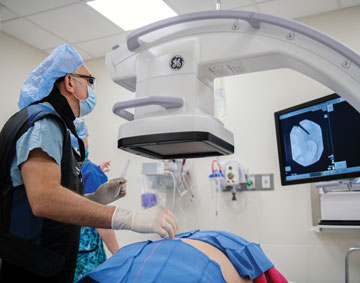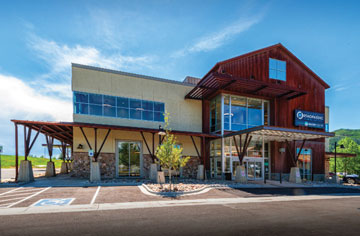"If you build it, they will come." That famous statement about building baseball fields in Iowa also applies to constructing new spine centers. With recent technological advances, shorter procedure and recovery times, not to mention a patient population that's wary of staying overnight in a hospital, now is the time to capitalize on the surging demand for outpatient spine surgery.
- Home
- Article
Starting a Spine Center From Scratch
By: Danielle Bouchat-Friedman
Published: 2/3/2021
Timing, location and plenty of physician involvement ultimately dictate the success of the project.
Worth the wait
UCHealth Yampa Valley Medical Center (YVMC), located in Steamboat Springs, Colo., had wanted to open an ambulatory surgery center for almost 20 years. The right opportunity finally came when it formed a partnership in early 2019 with Steamboat Orthopaedic & Spine Institute (SOSI). After a year of renovating a former Sports Authority location, the 27,000-square-foot building is unrecognizable from its former incarnation as a sporting goods retailer. The first floor houses the surgery center, and the second floor, home to the SOSI offices, has a waiting room with spectacular views of Steamboat Resort and Fish Creek Falls. It also offers two high-definition X-ray machines, which deliver images in extraordinary anatomical detail and reduce radiological exposure for patients and staff.
The facility gives patients a one-stop shop for orthopedic care: surgery, occupational therapy, X-ray, MRI, physical therapy, pain management injections and clinic appointments. Plus, the location was perfect — YVMC recognized the growing need for a multispecialty orthopedic center in a community that could serve residents and tourists. "Being associated with a local world-class ski resort, we're able to serve the local community and tourists from around the world," says Soniya Fidler, president of YVMC. "We're really proud that we're able to offer high-quality, low-cost options to the communities we serve."
The building had sat empty for about three years prior to construction, so it needed a fair number of renovations and restructuring in order to have the right layout and house all of the necessary equipment, says Clint Devin, MD, an orthopedic spine surgeon with SOSI. Then, there was the timing issue. SOSI opened in July of last year, right in the middle of the pandemic. The timing wasn't as bad as you'd imagine. "Because we were less busy clinically due to the pause in elective care, the pandemic allowed us additional time to focus on the renovations, restructuring and equipment, and get the regulatory requirements in place," says Dr. Devin.

NorthShore University HealthSystem (NorthShore) acquired Skokie (Ill.) Hospital in 2009 and continued to operate the facility as a general community hospital until April 2019, when it shifted its focus to orthopedic and spine specialties. Last year, the Orthopaedic & Spine Institute opened The NorthShore Spine Center at Skokie Hospital, bringing all of the group's spine specialists under one roof ?to treat spine conditions and complex back issues.
That change followed a $350 million investment over the last 10 years at the Skokie campus. "We currently have 12 operating rooms dedicated to orthopedic and spine care, and three pain procedure rooms," says Skokie Hospital President David Rahija. "In addition, we have eight more operating rooms dedicated to orthopedic and spine care being built and scheduled to come online by January 2022."
As the only specialty hospital in Illinois focused on orthopedic and spine conditions, the NorthShore Orthopaedic & Spine Institute made sure its 10 active neurosurgery and orthopedic spine surgeons had the cutting-edge technology they need to deliver the best outcomes. Here's what they are currently using as well as the approximate price tag for each item:
- Spine tables (seven) $150,000 each
- Wilson frames (five) $5,000 each
- Mayfield head positioner (two) $100,000 each
- C-arms (eight) $200,000 each
- Surgical microscopes (three) $500,000 each
- O-arm (three) $2,000,000 each
- Stealth navigation (four) $250,000 each, and
- Robots (two) $1,500,000 each.
Surgeon input
Regardless of whether you're creating a brand-new spine center from scratch or renovating an existing space, this much is always true: Physician participation is paramount. Dr. Devin participated in every step of SOSI's birth, even while he was still working as an associate professor of orthopedic surgery and neurosurgery at Vanderbilt University in Nashville, where he performed over 4,500 spine surgeries. "We wanted to make sure we understood what his calls were, what he was expecting from us and what we needed to provide for our patients," says Ms. Fidler. "It took several months of planning and meetings, but also just a lot of hands-on interactions."
That support was key because Dr. Devin admits to being somewhat particular when it comes to equipment. "We have a beautiful surgical microscope and there's a lot of new motion preservation technology that we are looking into adding," he says.
The facility is also trialing virtual reality goggles that are designed to ensure surgeons are making cuts in the right location. "Some of the spinal surgery techniques are very demanding, so the more technology surgeons have to help them operate, the more precise they can be," says Dr. Devin.
He says the primary goal with any spine surgery is motion preservation, and he's currently performing cervical laminectomies, ?anterior cervical fusions, cervical disc replacements, lumbar decompressions and lumbar fusions.
While it's common for surgeons to have a major say — or the ultimate decision — on the equipment and instrumentation that's purchased, SOSI surgeons also had a major impact on the layout of the facility, including the number of ORs they would need to handle cases. "I had pretty significant input into how the ORs would be designed, as did my colleagues," says Dr. Devin. "The key with spine is making sure the ORs are big enough to house the necessary equipment."
In the end, the facility settled on building two large ORs, but there were discussions about framing out three ORs that were slightly smaller. Dr. Devin says everyone ultimately agreed that they wanted the space to perform a wide breadth of complex cases, not just arthroscopic procedures.

The facility is also already looking into adding and utilizing robotic technology in the near future. "As we start to get into motion preservation and the exact placements of disc replacements, we'll probably see similarities to what happened with knee replacements, where greater precision and less frequent outlier cases ultimately increased the demand for the technology," says Dr. Devin. "We're also starting an FDA trial for a lumbar disc replacement in June, which will give us different options to alleviate nerve pain, yet maintain motion of the spine."
Follow-up is a must
Regardless of design, it's the experience patients receive inside your facility that will ultimately determine your success. And that experience should continue well after patients walk out your doors. Dr. Devin believes his team's commitment to the patient after surgery is what separates SOSI from other centers in the area. He says not only do they track patient satisfaction and safety of care, but they also extensively track patient-reported outcomes. SOSI surgeons want to know how their patients improved from the surgery. That's why they track patients just prior to surgery, three months afterward and one year following the procedure, and present this information to patients in a clear and transparent manner. "Aside from word of mouth, patient-reported outcomes are a way of saying: 'Here's what you're getting for your money and your outcome,'" says Dr. Devin. "The proof is in the pudding." OSM
.svg?sfvrsn=be606e78_3)
.svg?sfvrsn=56b2f850_5)